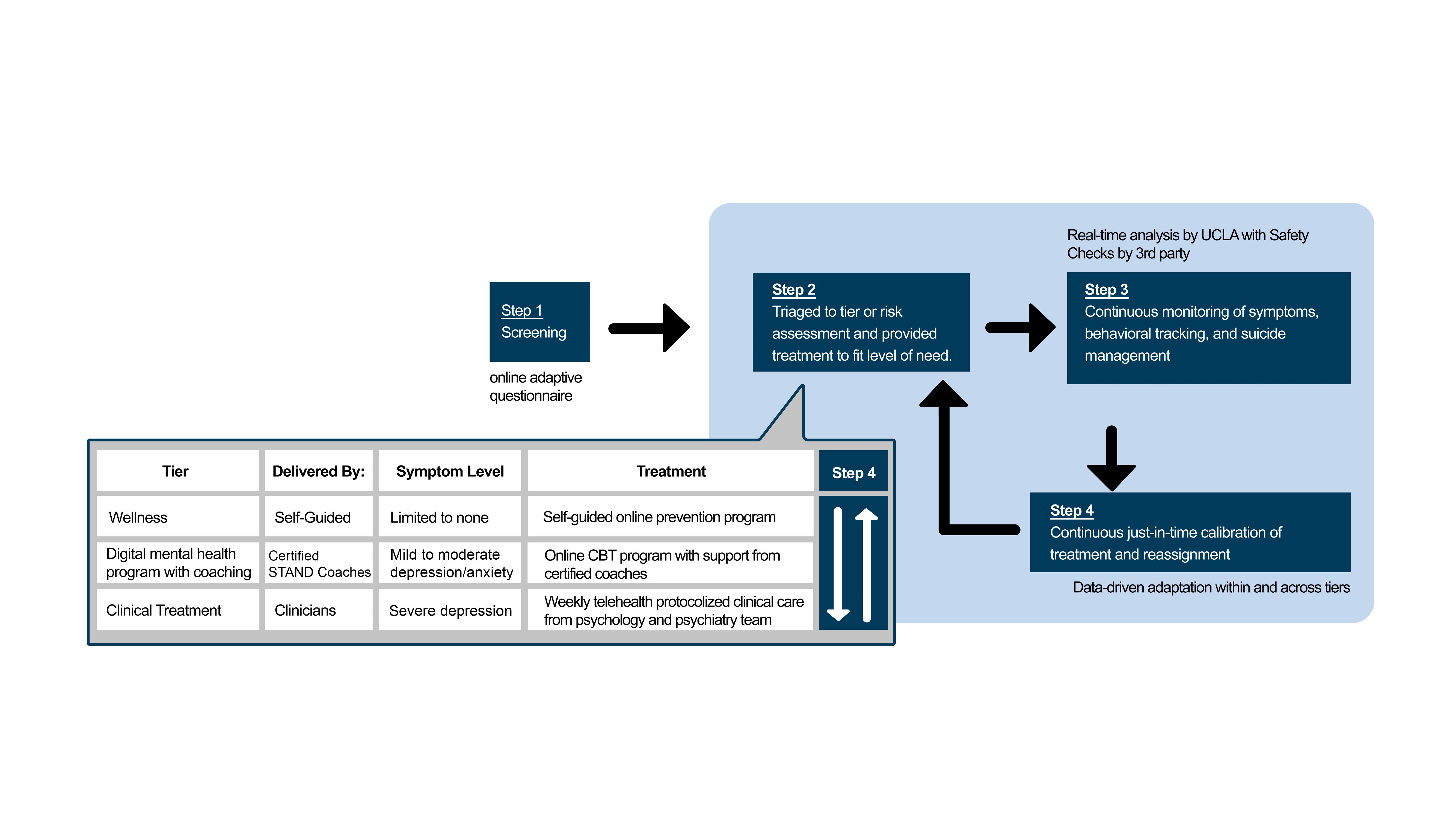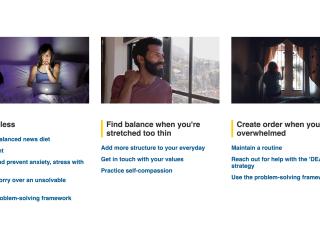The STAND (Screening and Treatment for Anxiety and Depression) program is an all-in-one, end-to-end system of care which includes screening, triaging, delivery of services, ongoing monitoring of mood and symptoms and intervention recalibration. The DGC's strategy is to demonstrate the STAND system of care in a variety of settings and communities, serving as a framework that can be adapted for the communities' needs. We continue to enhance STAND in response to ongoing research and communication with the communities we serve.

How STAND Works
Leveraging an online screening tool, participants are screened for symptoms of anxiety, depression and suicidality, triaged to the level of care matching their needs: wellness tier (for people with no symptoms), a digital mental health program paired with certified coaches (for people with mild to severe anxiety or mild to moderate depression) and clinical care (for people who are at risk for severe depression or suicidality). Participants commence services in the recommended tier and are routinely assessed, followed by just-in-time calibration of the treatment level as symptoms indicate.
How STAND Started
The STAND system of care was conceptualized in 2017 by Michelle Craske for the Depression Grand Challenge. It was developed in recognition that we needed to take action to develop a new way to effectively reach and treat more people. A key tenet of the STAND program is that clinicians are reserved for only the most severely depressed, and for people with less severe symptoms, we leverage digital lessons complemented with sessions with certified STAND coaches.
The first implementation of STAND (now referred to as STAND 1.0) began as a pilot research project with the UCLA student body in early 2017, and by Fall 2017 was open to the student community. We operated this form of STAND until 2020.
Vision & Funding of STAND 2.0
The team had a vision that we could develop new digital materials that would better speak to the student community and furthermore that we could have a system that would better facilitate the recalibration that we needed to support the adjustment of participants’ tiers. We shared this vision with our Leadership Council and friends and soon secured funding to build STAND 2.0 — digital content that would allow for more personalization of lessons, and a platform to deliver this content.
Key Features of STAND 2.0
- Online adaptive screening of symptoms and history with ongoing monitoring of symptoms
- Triaging of participants to a level of care based on symptoms (Tiers 1, 2 and 3)
- 24-hour risk assessment and response for individuals who may be at risk for self-harm or harm to others
- Protocolized psychological and psychiatric care for those requiring Tier 3 services
- UCLA-developed content delivered digitally to address a variety of common issues such as worry, low mood, trauma, panic, sleep concerns, eating disorders, etc.
- Support of digitally delivered content by UCLA trained and certified STAND coaches (STAND Coaching Program)
- Ongoing calibration of level of care (up or down) in response to changes in symptoms.
- Digital platform to manage participants and deliver content.
Full STAND 2.0 Service Implementations
While the first implementation of the system of care was with the UCLA student body in 2017, this version did not feature the new content or platform. The full system of care incorporating the STAND 2.0 features was implemented at East Los Angeles College. This demonstration program was funded by the Los Angeles County Department of Mental Health in 2020, with the first participants seen in 2021. The program continued as a service offering until Sept. 30, 2023. UCLA's relationships with ELAC continues as a research implementation (see below).
STAND 2.0 Research Project Implementations
The DGC continues to conduct research involving different aspects and features of STAND 2.0.
- STAND for college students:
- ELAC: With funding from the NIMH, we are currently studying: level of care assignment, coaching effectiveness, suicide risk management and recruitment barriers. These projects were funded as part of the NIMH STAND ALACRITY Center. Research began in Fall 2023 and is scheduled to continue through Spring 2027.
- Imperial Valley College: Awarded from Wellcome to the University of Exeter, the DGC is part of a research team conducting multi-site clinical trials with STAND in late 2025/early 2026. The planned U.S. site is at Imperial Valley College.
- STAND for birth parents: We operated a study, STAND for Pregnant and New Moms, to validate the effectiveness of new digital content developed for pregnant and new birthing parents. Data collection for this study was completed in January 2024.
Elements of STAND 2.0 Leveraged for Other Implementations
Aside from our research projects, we have other implementations that are leveraging various STAND components including:
- STAR Program (STAND at UCLA), which began in Feb. 2022
- STAND for All, which began in May 2021
- COVID-19 Care Package launched on April 23, 2020, now sunsetted
- STAND Tips, launched in Dec. 2023 as a successor to the COVID-19 Care Package
- STAND Wellness Resource (pilot), launched July 2024
Current Activity & Priorities
- Ongoing research through the STAND at ELAC implementation
- Preparing for STAND at Imperial Valley research project
- Analyzing data from STAND for Pregnant and New Moms research project
- Ongoing operation of STAR (STAND at UCLA)
- Ongoing development and improvement of STAND Content, including Spanish language translation
- Launch of STAND Wellness Resource pilot
Create a gold-standard system of care that leverages digital technology to screen, triage, deliver and adapt personalized, evidence-based treatment. The system should be effective, customizable, scalable, adaptable and accessible, which the DGC will assure by demonstrating in a variety of settings and communities.
Indefinite
Academic Founder & Leader: Michelle Craske
The initial research involving STAND 1.0 was funded by UCLA. Thanks to the generosity of donors, we were able to create custom STAND content and a platform for delivering the content. Please refer to individual project sheets for detail about how each implementation was funded.







